Time Independent Perturbation Theory, 1st order correction, 2nd order correction
Download as PPT, PDF24 likes18,543 views
The presentation is about how to solve the new energy levels and wave functions when the simple Hamiltonian is added by another term due to external effect (can be due to external field) . The intended reader of this presentation were physics students. The author already assumed that the reader knows dirac braket notation.
1 of 22
Downloaded 350 times



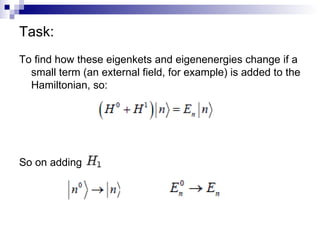

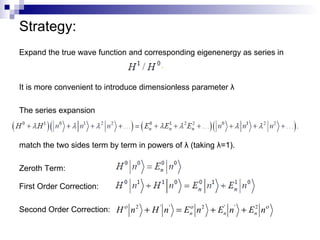
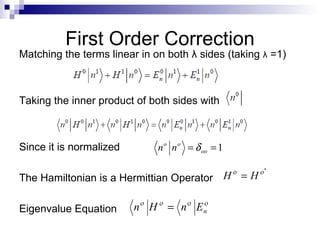

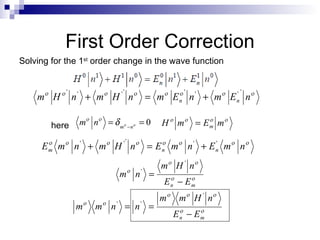
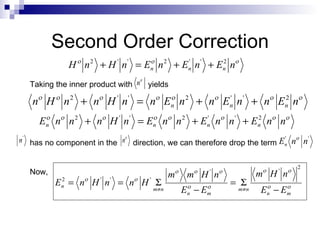
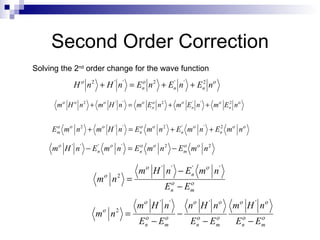
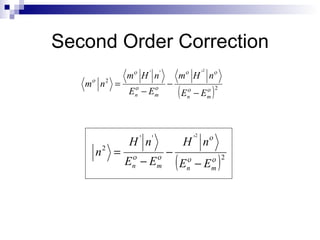
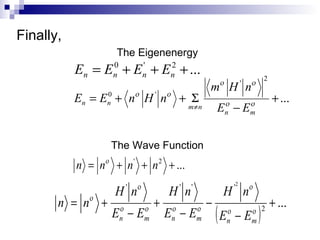









Recommended
Perturbation



PerturbationBHAVANAR12
╠²
The document discusses first order perturbation theory. It begins by introducing perturbation theory as an approximate method to solve the Schrodinger equation for complex quantum systems where the Hamiltonian cannot be solved exactly. It then presents the key equations of first order perturbation theory. The first order correction to the energy is given by the expectation value of the perturbation operator over the unperturbed ground state wavefunction. The first order correction to the wavefunction is expressed as a linear combination of unperturbed eigenstates.Brief introduction to perturbation theory



Brief introduction to perturbation theoryAnamika Banerjee
╠²
Perturbation theory allows approximations of quantum systems where exact solutions cannot be easily determined. It involves splitting the Hamiltonian into known and perturbative terms. For the helium atom, the zero-order approximation treats it as two independent hydrogen atoms, yielding the wrong energy. The first-order approximation includes repulsion between electrons, giving a better but still incorrect energy. Variational theory provides an energy always greater than or equal to the actual energy.Introduction to perturbation theory, part-1



Introduction to perturbation theory, part-1Kiran Padhy
╠²
Perturbation theory provides an approximate method for solving quantum mechanical problems where the Hamiltonian cannot be solved exactly. It involves splitting the Hamiltonian into an exactly solvable unperturbed part (H0) and a perturbed part (H1) treated as a small disturbance. The eigenvalues and eigenstates of the full Hamiltonian are expressed as power series expansions in terms of the perturbation strength parameter ╬╗, allowing the effects of the perturbation to be calculated order by order. There are two types of perturbation theory: time-independent, where the unperturbed eigenstates are stationary; and time-dependent, where they vary with time under the perturbation.Part V - The Hydrogen Atom



Part V - The Hydrogen AtomMaurice R. TREMBLAY
╠²
The document summarizes key details about the hydrogen atom and its electron orbital structure based on quantum mechanics. It provides:
1) A direct observation of the electron orbital of a hydrogen atom placed in an electric field, obtained through photoionization microscopy. Interference patterns observed directly reflect the nodal structure of the wavefunction.
2) Calculated and measured probability patterns for the electron in different energy levels of the hydrogen atom are shown. Bright regions correspond to high probability of finding the electron.
3) An overview of solving the radial, angular and azimuthal coordinate functions of the hydrogen atom through series expansion, as exact solutions have not been found. Approximate solutions can be obtained for more complex atoms like heTime Dependent Perturbation Theory



Time Dependent Perturbation TheoryJames Salveo Olarve
╠²
The presentation is about how to evaluate the probability of finding the system in any particular state at any later time when the simple Hamiltonian was added by time dependent perturbation. So now the wave function will have perturbation-induced time dependence.Hydrogen atom



Hydrogen atomAnilkumar Shoibam
╠²
This document summarizes the key steps in solving the time-independent Schrodinger equation for the hydrogen atom using spherical polar coordinates. It separates the equation into three one-dimensional equations for the radial, angular, and azimuthal variables (R(r), ╬ś(╬Ė), ╬”(Žå)). Solving each equation shows they are only satisfied for discrete quantum numbers like angular momentum l and principal quantum number n, resulting in quantization of the hydrogen atom's energy levels.Schrodinger equation and its applications: Chapter 2



Schrodinger equation and its applications: Chapter 2Dr.Pankaj Khirade
╠²
Wave function and its physical significance, Schrodinger time dependent equation, Separation in time dependent and time independent parts, Operators in quantum Mechanics, Eigen functions and Eigen values, Particle in one dimensional and three dimensional box (Energy eigen values). Qualitative analysis of potential barrier Tunneling effect). Simple Harmonic Oscillator (Qualitative analysis of Zero point energy)
CHAPTER 6 Quantum Mechanics II



CHAPTER 6 Quantum Mechanics IIThepsatri Rajabhat University
╠²
CHAPTER 6 Quantum Mechanics II
6.0 Partial differentials
6.1 The Schr├Čdinger Wave Equation
6.2 Expectation Values
6.3 Infinite Square-Well Potential
6.4 Finite Square-Well Potential
6.5 Three-Dimensional Infinite-Potential Well
6.6 Simple Harmonic Oscillator
6.7 Barriers and Tunneling in some books an extra chapter due to its technical importanceStarkEffect.ppt



StarkEffect.pptIdrisMammadov
╠²
The Stark effect is the splitting and shifting of spectral lines in atoms and molecules due to an external electric field. Johannes Stark discovered the effect in 1913 when he observed the spectral lines of hydrogen split into symmetrically spaced components under an electric field. The amount of splitting or shifting is quantified as the Stark shift or splitting. The effect occurs due to the interaction of the electric field with the charged particles in the atom, causing a perturbation to the electron orbitals and thus changing the energy levels.Ph 101-9 QUANTUM MACHANICS



Ph 101-9 QUANTUM MACHANICSChandan Singh
╠²
The document provides an outline for a course on quantum mechanics. It discusses key topics like the time-dependent Schrodinger equation, eigenvalues and eigenfunctions, boundary conditions for wave functions, and applications like the particle in a box model. Specific solutions to the Schrodinger equation are explored for stationary states with definite energy, including the wave function for a free particle and the quantization of energy for a particle confined to a one-dimensional box.Particle in 1 D box



Particle in 1 D boxPradeep Samantaroy
╠²
Particle in 1D Box, useful for MSc and BSc Chemistry studentsQuantum mechanics a brief



Quantum mechanics a briefChaitanya Areti
╠²
Quantum mechanics describes the behavior of matter and light on the atomic and subatomic scale. Some key points of the quantum mechanics view are that particles can exhibit both wave-like and particle-like properties, their behavior is probabilistic rather than definite, and some properties like position and momentum cannot be known simultaneously with complete precision due to the Heisenberg uncertainty principle. Quantum mechanics has successfully explained various phenomena that classical physics could not and led to important technologies like lasers, MRI machines, and semiconductor devices.Compton effect



Compton effectAnteneh Andualem
╠²
The document discusses the Compton effect, which describes the scattering of photons by charged particles like electrons. It provides the mathematical description using conservation of energy and momentum. The Compton effect leads to a shift in the wavelength of scattered photons. Practical applications of the Compton effect include Compton scatter densitometry to measure electron density, Compton scatter imaging for 3D electron density mapping, and Compton profile analysis to characterize materials.Anamolous zeeman effect



Anamolous zeeman effectPradeepkumar Yadav
╠²
Russell Saunders coupling and J-J coupling describe different schemes for coupling angular momenta in atomic systems. Russell Saunders coupling occurs when spin-orbit interactions are weaker than interactions between electrons. It involves combining orbital angular momenta (L) and spins (S) into total angular momentum (J). J-J coupling occurs in heavy atoms where spin-orbit interactions are strong. It involves first combining orbital and spin angular momenta for individual electrons (j) and then combining the j values. The document also discusses the anomalous Zeeman effect, Paschen-Back effect, and applications of the Fabry-Perot interferometer for measuring Zeeman splitting.Limitations OF Classical Physics and Birth Of Quantum Mechanics



Limitations OF Classical Physics and Birth Of Quantum MechanicsCENTER FOR HIGH ENERGY PHYSICS
╠²
Classical mechanics fails to explain several experimental observations such as:
1) Black-body radiation spectrum
2) Photoelectric effect
3) Compton scattering
4) Spectrum of hydrogen emissions
Quantum mechanics was developed to account for these phenomena by treating electrons as both particles and waves. Max Planck proposed quanta to explain black-body radiation, while Albert Einstein and Niels Bohr used quanta to explain the photoelectric effect and hydrogen spectrum respectively. Arthur Compton also explained Compton scattering using photons colliding with electrons.Statics presentation ppt(1)



Statics presentation ppt(1)SrinivasaKalkani
╠²
This document provides an introduction to statistical mechanics and different types of statistics. It discusses classical statistics, which includes Maxwell-Boltzmann statistics, and quantum statistics, which includes Bose-Einstein (B-E) and Fermi-Dirac (F-D) statistics. Maxwell-Boltzmann statistics treats particles as distinguishable and applies to ideal gases, while B-E and F-D statistics treat particles as indistinguishable and apply to photons/bosons and electrons/fermions, respectively. The key differences between the statistics are whether particles can occupy the same state (B-E allows multiple occupancy, F-D allows only single occupancy) and the formulas that describe the most probable distribution of particlesIntroduction to quantum mechanics and schrodinger equation



Introduction to quantum mechanics and schrodinger equationGaurav Singh Gusain
╠²
Classical mechanics describes macroscopic objects while quantum mechanics describes microscopic objects due to limitations of classical theory. Quantum mechanics was introduced after classical mechanics failed to explain experimental observations involving microscopic particles. Some key aspects of quantum mechanics are the photoelectric effect, blackbody radiation, Compton effect, wave-particle duality, the Heisenberg uncertainty principle, and Schrodinger's wave equation. Schrodinger's equation describes the wave function and probability of finding a particle.The Variational Method



The Variational MethodJames Salveo Olarve
╠²
This presentation shows a technique of how to solve for the approximate ground state energy using Schrodinger Equation in which the solution for wave function is not on hand6563.nuclear models



6563.nuclear modelsakshay garg
╠²
1. Nuclear models like the liquid drop model and shell model describe aspects of nuclear structure and behavior. The liquid drop model treats the nucleus like a liquid drop while the shell model treats nucleons as moving independently in nuclear orbits.
2. The shell model explains nuclear magic numbers and properties like spin and parity. Magic numbers correspond to nuclear stability when the number of protons or neutrons equals 2, 8, 20, 28, 50, 82, etc. The shell model accounts for magic numbers in terms of closed nuclear shells.
3. While insightful, nuclear models have limitations and do not fully describe all nuclear phenomena. The liquid drop model cannot explain magic numbers while the shell model fails to explain the stability of certainstatistic mechanics



statistic mechanicsDharmendrapresentation
╠²
This document provides an overview of statistical mechanics. It defines microstates and macrostates, and explains that statistical mechanics studies systems with many microstates corresponding to a given macrostate. The Boltzmann distribution is derived, which gives the probability of finding a system in a particular microstate as being proportional to the exponential of the negative of the energy of that microstate divided by the temperature. Maxwell-Boltzmann statistics are described as applying to classical distinguishable particles, yielding the Maxwell-Boltzmann distribution. References for further reading are also included.quantum view of Harmonic oscillator 



quantum view of Harmonic oscillator Ahmed Haider
╠²
The harmonic oscillator played a key role in early quantum theory. Planck, Einstein, and others assumed that atoms, radiation, and solids behaved like quantum harmonic oscillators to explain phenomena like blackbody radiation and heat capacities. This led to the development of quantum theory for electromagnetic and mechanical oscillators. Solving the Schr├Čdinger equation for the harmonic oscillator yields discrete energy levels and eigenfunctions that describe its quantized energy spectrum.Ls coupling



Ls couplingusman mustafa
╠²
This document discusses different types of angular momentum coupling in quantum physics, specifically LS coupling and JJ coupling. It defines LS coupling as when orbital angular momentum (L) and spin angular momentum (S) weakly interact to form total angular momentum (J). JJ coupling occurs for heavier elements where each electron's orbital and spin angular momenta strongly combine into J vectors that then couple. The document provides examples of calculating L, S, J values and term symbols for different electron configurations under LS coupling.M├Čssbauer spectroscopy ppt



M├Čssbauer spectroscopy pptImranKhan3719
╠²
M├Čssbauer spectroscopy involves the interaction of gamma rays with atoms and molecules. It provides information about the chemical environment and oxidation states of atoms based on how they absorb gamma rays. For the M├Čssbauer effect to occur, the emitting and absorbing atoms must be embedded in a solid crystal lattice to minimize recoil effects. This allows the resonant absorption of gamma rays. Analysis of parameters like isomer shift, electric quadrupole interactions, and magnetic interactions in the Mossbauer spectrum provide details about the chemical environment and oxidation state of atoms in a sample.Operators n dirac in qm



Operators n dirac in qmAnda Tywabi
╠²
This lecture discusses operator methods in quantum mechanics. Some key points:
1. Operators allow quantum mechanics to be formulated without relying on a particular basis. The Hamiltonian operator H acts on state vectors.
2. Dirac notation represents state vectors as "kets" and defines inner products between states. A resolution of identity allows expanding states in a basis.
3. Hermitian operators correspond to physical observables. Their eigenfunctions form a complete basis. The time-evolution operator evolves states forward in time.
4. The uncertainty principle relates the uncertainties of non-commuting operators like position and momentum. Symmetries of the Hamiltonian are represented by unitary operators that commute with it.Lecture7



Lecture7Heather Kulik
╠²
Lecture 8: Introduction to Quantum Chemical Simulation graduate course taught at MIT in Fall 2014 by Heather Kulik. This course covers: wavefunction theory, density functional theory, force fields and molecular dynamics and sampling.Zeeman Effect



Zeeman EffectZeeshan Khalid
╠²
The Zeeman effect is the splitting of a spectral line into multiple spectral lines when in the presence of a magnetic field. It was first observed in 1896 by Dutch physicist Pieter Zeeman when he placed a sodium flame between magnetic poles and observed the broadening of spectral lines. Zeeman's discovery earned him the 1902 Nobel Prize in Physics. The pattern and amount of splitting provides information about the strength and presence of the magnetic field.Dft presentation



Dft presentationSaibalendu Sarkar
╠²
Density functional theory (DFT) provides an alternative approach to calculate properties of molecules by working with electron density rather than wave functions. DFT relies on two theorems linking the ground state energy and electron density. Approximations must be made for the exchange-correlation functional, with popular approximations including LDA, GGA, and hybrid functionals. DFT calculations can determine properties like molecular geometries, energies, vibrational frequencies, and more using software packages. While computationally efficient, DFT has limitations such as its reliance on approximate exchange-correlation functionals.Vibrational Spectrroscopy



Vibrational Spectrroscopycdtpv
╠²
Lecture delivered by Prof. David Lidzey, University of Sheffield, as part of CDT-PV core-level training, Jan 2016Chemistry Assignment Help



Chemistry Assignment HelpEdu Assignment Help
╠²
I am Grey N. I am a Chemistry Assignment Expert at eduassignmenthelp.com. I hold a Ph.D. in Chemistry, from Calgary, Canada. I have been helping students with their homework for the past 6 years. I solve assignments related to Chemistry.
Visit eduassignmenthelp.com or email info@eduassignmenthelp.com.
You can also call on +1 678 648 4277 for any assistance with Chemistry Assignments.
General Chemistry I - CHEM 181Critical Thinking Exercise.docx



General Chemistry I - CHEM 181Critical Thinking Exercise.docxbudbarber38650
╠²
General Chemistry I - CHEM 181
Critical Thinking Exercise #3
Due Thursday, Oct. 24
Name_________________________
Section _______
Why do excited hydrogen atoms emit only specific wavelengths of light?
Introduction
In the 1800ŌĆÖs scientists discovered that a glass cylinder containing a low pressure of a gas will emit light when high voltage electricity is applied to metal electrodes inserted at opposite ends of the cylinder. This principal is used in fluorescent lighting today. When the light emitted by a particular gas, for instance hydrogen, was analyzed by passing it through a prism, scientists were surprised to find that only a few specific wavelengths of visible light were emitted, rather than a continuous range of wavelengths. This mystery took over 70 years to fully solve.
wavelength, (nm)
Infrared
Ultraviolet (uv)
Over time, scientists discovered that the wavelengths of radiation emitted by hydrogen extended from the ultraviolet through the visible into the infrared, microwave, and radio wave portions of the electromagnetic (EM) spectrum. There appeared to be a pattern in the wavelengths that consisted of a series of series of lines. The first 4 series starting from the shortest wavelength line are named for the people that discovered them.
In 1885 J.J. Balmer discovered a mathematical pattern in the wavelengths emitted by hydrogen in the visible and near ultraviolet regions of the electromagnetic spectrum:
Each allowed value for n plugged into this equation produces one of the wavelengths of light emitted by hydrogen in the region of the spectrum that Balmer studied.
Five years later another scientist, Johannes Rydberg, extended this equation so that it could predict all of the wavelengths emitted by hydrogen in all regions of the electromagnetic spectrum:
(eq. 1)
This equation contains two integers that must be greater than zero and the value of n must be greater than the value of m. The way it works is that the value of m specifies the series, e.g. m = 3 is necessary to generate the wavelengths observed in the Paschen series and n = 4,5,6ŌĆ” will generate the wavelengths emitted within that series. The constant R is known as the Rydberg constant.
Though the equations from Balmer and Rydberg demonstrated mathematical skill, they did not answer the big question on the minds of many scientists: Why do the atoms of hydrogen in the gas phase emit only certain wavelengths of radiation and why do the wavelengths have the pattern described by these clever equations. As it turned out, the solution to this riddle completely altered civilization on this planet.
Part I ŌĆō Putting together pieces of the puzzle
Part of the reason that it took so long to solve hydrogen line spectrum puzzle was that scientists at the time had an incomplete understanding of light. Specifically, they were not aware of any relationship between the energy of light and the wavelength. It was assumed that the ene.More Related Content
What's hot (20)
StarkEffect.ppt



StarkEffect.pptIdrisMammadov
╠²
The Stark effect is the splitting and shifting of spectral lines in atoms and molecules due to an external electric field. Johannes Stark discovered the effect in 1913 when he observed the spectral lines of hydrogen split into symmetrically spaced components under an electric field. The amount of splitting or shifting is quantified as the Stark shift or splitting. The effect occurs due to the interaction of the electric field with the charged particles in the atom, causing a perturbation to the electron orbitals and thus changing the energy levels.Ph 101-9 QUANTUM MACHANICS



Ph 101-9 QUANTUM MACHANICSChandan Singh
╠²
The document provides an outline for a course on quantum mechanics. It discusses key topics like the time-dependent Schrodinger equation, eigenvalues and eigenfunctions, boundary conditions for wave functions, and applications like the particle in a box model. Specific solutions to the Schrodinger equation are explored for stationary states with definite energy, including the wave function for a free particle and the quantization of energy for a particle confined to a one-dimensional box.Particle in 1 D box



Particle in 1 D boxPradeep Samantaroy
╠²
Particle in 1D Box, useful for MSc and BSc Chemistry studentsQuantum mechanics a brief



Quantum mechanics a briefChaitanya Areti
╠²
Quantum mechanics describes the behavior of matter and light on the atomic and subatomic scale. Some key points of the quantum mechanics view are that particles can exhibit both wave-like and particle-like properties, their behavior is probabilistic rather than definite, and some properties like position and momentum cannot be known simultaneously with complete precision due to the Heisenberg uncertainty principle. Quantum mechanics has successfully explained various phenomena that classical physics could not and led to important technologies like lasers, MRI machines, and semiconductor devices.Compton effect



Compton effectAnteneh Andualem
╠²
The document discusses the Compton effect, which describes the scattering of photons by charged particles like electrons. It provides the mathematical description using conservation of energy and momentum. The Compton effect leads to a shift in the wavelength of scattered photons. Practical applications of the Compton effect include Compton scatter densitometry to measure electron density, Compton scatter imaging for 3D electron density mapping, and Compton profile analysis to characterize materials.Anamolous zeeman effect



Anamolous zeeman effectPradeepkumar Yadav
╠²
Russell Saunders coupling and J-J coupling describe different schemes for coupling angular momenta in atomic systems. Russell Saunders coupling occurs when spin-orbit interactions are weaker than interactions between electrons. It involves combining orbital angular momenta (L) and spins (S) into total angular momentum (J). J-J coupling occurs in heavy atoms where spin-orbit interactions are strong. It involves first combining orbital and spin angular momenta for individual electrons (j) and then combining the j values. The document also discusses the anomalous Zeeman effect, Paschen-Back effect, and applications of the Fabry-Perot interferometer for measuring Zeeman splitting.Limitations OF Classical Physics and Birth Of Quantum Mechanics



Limitations OF Classical Physics and Birth Of Quantum MechanicsCENTER FOR HIGH ENERGY PHYSICS
╠²
Classical mechanics fails to explain several experimental observations such as:
1) Black-body radiation spectrum
2) Photoelectric effect
3) Compton scattering
4) Spectrum of hydrogen emissions
Quantum mechanics was developed to account for these phenomena by treating electrons as both particles and waves. Max Planck proposed quanta to explain black-body radiation, while Albert Einstein and Niels Bohr used quanta to explain the photoelectric effect and hydrogen spectrum respectively. Arthur Compton also explained Compton scattering using photons colliding with electrons.Statics presentation ppt(1)



Statics presentation ppt(1)SrinivasaKalkani
╠²
This document provides an introduction to statistical mechanics and different types of statistics. It discusses classical statistics, which includes Maxwell-Boltzmann statistics, and quantum statistics, which includes Bose-Einstein (B-E) and Fermi-Dirac (F-D) statistics. Maxwell-Boltzmann statistics treats particles as distinguishable and applies to ideal gases, while B-E and F-D statistics treat particles as indistinguishable and apply to photons/bosons and electrons/fermions, respectively. The key differences between the statistics are whether particles can occupy the same state (B-E allows multiple occupancy, F-D allows only single occupancy) and the formulas that describe the most probable distribution of particlesIntroduction to quantum mechanics and schrodinger equation



Introduction to quantum mechanics and schrodinger equationGaurav Singh Gusain
╠²
Classical mechanics describes macroscopic objects while quantum mechanics describes microscopic objects due to limitations of classical theory. Quantum mechanics was introduced after classical mechanics failed to explain experimental observations involving microscopic particles. Some key aspects of quantum mechanics are the photoelectric effect, blackbody radiation, Compton effect, wave-particle duality, the Heisenberg uncertainty principle, and Schrodinger's wave equation. Schrodinger's equation describes the wave function and probability of finding a particle.The Variational Method



The Variational MethodJames Salveo Olarve
╠²
This presentation shows a technique of how to solve for the approximate ground state energy using Schrodinger Equation in which the solution for wave function is not on hand6563.nuclear models



6563.nuclear modelsakshay garg
╠²
1. Nuclear models like the liquid drop model and shell model describe aspects of nuclear structure and behavior. The liquid drop model treats the nucleus like a liquid drop while the shell model treats nucleons as moving independently in nuclear orbits.
2. The shell model explains nuclear magic numbers and properties like spin and parity. Magic numbers correspond to nuclear stability when the number of protons or neutrons equals 2, 8, 20, 28, 50, 82, etc. The shell model accounts for magic numbers in terms of closed nuclear shells.
3. While insightful, nuclear models have limitations and do not fully describe all nuclear phenomena. The liquid drop model cannot explain magic numbers while the shell model fails to explain the stability of certainstatistic mechanics



statistic mechanicsDharmendrapresentation
╠²
This document provides an overview of statistical mechanics. It defines microstates and macrostates, and explains that statistical mechanics studies systems with many microstates corresponding to a given macrostate. The Boltzmann distribution is derived, which gives the probability of finding a system in a particular microstate as being proportional to the exponential of the negative of the energy of that microstate divided by the temperature. Maxwell-Boltzmann statistics are described as applying to classical distinguishable particles, yielding the Maxwell-Boltzmann distribution. References for further reading are also included.quantum view of Harmonic oscillator 



quantum view of Harmonic oscillator Ahmed Haider
╠²
The harmonic oscillator played a key role in early quantum theory. Planck, Einstein, and others assumed that atoms, radiation, and solids behaved like quantum harmonic oscillators to explain phenomena like blackbody radiation and heat capacities. This led to the development of quantum theory for electromagnetic and mechanical oscillators. Solving the Schr├Čdinger equation for the harmonic oscillator yields discrete energy levels and eigenfunctions that describe its quantized energy spectrum.Ls coupling



Ls couplingusman mustafa
╠²
This document discusses different types of angular momentum coupling in quantum physics, specifically LS coupling and JJ coupling. It defines LS coupling as when orbital angular momentum (L) and spin angular momentum (S) weakly interact to form total angular momentum (J). JJ coupling occurs for heavier elements where each electron's orbital and spin angular momenta strongly combine into J vectors that then couple. The document provides examples of calculating L, S, J values and term symbols for different electron configurations under LS coupling.M├Čssbauer spectroscopy ppt



M├Čssbauer spectroscopy pptImranKhan3719
╠²
M├Čssbauer spectroscopy involves the interaction of gamma rays with atoms and molecules. It provides information about the chemical environment and oxidation states of atoms based on how they absorb gamma rays. For the M├Čssbauer effect to occur, the emitting and absorbing atoms must be embedded in a solid crystal lattice to minimize recoil effects. This allows the resonant absorption of gamma rays. Analysis of parameters like isomer shift, electric quadrupole interactions, and magnetic interactions in the Mossbauer spectrum provide details about the chemical environment and oxidation state of atoms in a sample.Operators n dirac in qm



Operators n dirac in qmAnda Tywabi
╠²
This lecture discusses operator methods in quantum mechanics. Some key points:
1. Operators allow quantum mechanics to be formulated without relying on a particular basis. The Hamiltonian operator H acts on state vectors.
2. Dirac notation represents state vectors as "kets" and defines inner products between states. A resolution of identity allows expanding states in a basis.
3. Hermitian operators correspond to physical observables. Their eigenfunctions form a complete basis. The time-evolution operator evolves states forward in time.
4. The uncertainty principle relates the uncertainties of non-commuting operators like position and momentum. Symmetries of the Hamiltonian are represented by unitary operators that commute with it.Lecture7



Lecture7Heather Kulik
╠²
Lecture 8: Introduction to Quantum Chemical Simulation graduate course taught at MIT in Fall 2014 by Heather Kulik. This course covers: wavefunction theory, density functional theory, force fields and molecular dynamics and sampling.Zeeman Effect



Zeeman EffectZeeshan Khalid
╠²
The Zeeman effect is the splitting of a spectral line into multiple spectral lines when in the presence of a magnetic field. It was first observed in 1896 by Dutch physicist Pieter Zeeman when he placed a sodium flame between magnetic poles and observed the broadening of spectral lines. Zeeman's discovery earned him the 1902 Nobel Prize in Physics. The pattern and amount of splitting provides information about the strength and presence of the magnetic field.Dft presentation



Dft presentationSaibalendu Sarkar
╠²
Density functional theory (DFT) provides an alternative approach to calculate properties of molecules by working with electron density rather than wave functions. DFT relies on two theorems linking the ground state energy and electron density. Approximations must be made for the exchange-correlation functional, with popular approximations including LDA, GGA, and hybrid functionals. DFT calculations can determine properties like molecular geometries, energies, vibrational frequencies, and more using software packages. While computationally efficient, DFT has limitations such as its reliance on approximate exchange-correlation functionals.Vibrational Spectrroscopy



Vibrational Spectrroscopycdtpv
╠²
Lecture delivered by Prof. David Lidzey, University of Sheffield, as part of CDT-PV core-level training, Jan 2016Similar to Time Independent Perturbation Theory, 1st order correction, 2nd order correction (20)
Chemistry Assignment Help



Chemistry Assignment HelpEdu Assignment Help
╠²
I am Grey N. I am a Chemistry Assignment Expert at eduassignmenthelp.com. I hold a Ph.D. in Chemistry, from Calgary, Canada. I have been helping students with their homework for the past 6 years. I solve assignments related to Chemistry.
Visit eduassignmenthelp.com or email info@eduassignmenthelp.com.
You can also call on +1 678 648 4277 for any assistance with Chemistry Assignments.
General Chemistry I - CHEM 181Critical Thinking Exercise.docx



General Chemistry I - CHEM 181Critical Thinking Exercise.docxbudbarber38650
╠²
General Chemistry I - CHEM 181
Critical Thinking Exercise #3
Due Thursday, Oct. 24
Name_________________________
Section _______
Why do excited hydrogen atoms emit only specific wavelengths of light?
Introduction
In the 1800ŌĆÖs scientists discovered that a glass cylinder containing a low pressure of a gas will emit light when high voltage electricity is applied to metal electrodes inserted at opposite ends of the cylinder. This principal is used in fluorescent lighting today. When the light emitted by a particular gas, for instance hydrogen, was analyzed by passing it through a prism, scientists were surprised to find that only a few specific wavelengths of visible light were emitted, rather than a continuous range of wavelengths. This mystery took over 70 years to fully solve.
wavelength, (nm)
Infrared
Ultraviolet (uv)
Over time, scientists discovered that the wavelengths of radiation emitted by hydrogen extended from the ultraviolet through the visible into the infrared, microwave, and radio wave portions of the electromagnetic (EM) spectrum. There appeared to be a pattern in the wavelengths that consisted of a series of series of lines. The first 4 series starting from the shortest wavelength line are named for the people that discovered them.
In 1885 J.J. Balmer discovered a mathematical pattern in the wavelengths emitted by hydrogen in the visible and near ultraviolet regions of the electromagnetic spectrum:
Each allowed value for n plugged into this equation produces one of the wavelengths of light emitted by hydrogen in the region of the spectrum that Balmer studied.
Five years later another scientist, Johannes Rydberg, extended this equation so that it could predict all of the wavelengths emitted by hydrogen in all regions of the electromagnetic spectrum:
(eq. 1)
This equation contains two integers that must be greater than zero and the value of n must be greater than the value of m. The way it works is that the value of m specifies the series, e.g. m = 3 is necessary to generate the wavelengths observed in the Paschen series and n = 4,5,6ŌĆ” will generate the wavelengths emitted within that series. The constant R is known as the Rydberg constant.
Though the equations from Balmer and Rydberg demonstrated mathematical skill, they did not answer the big question on the minds of many scientists: Why do the atoms of hydrogen in the gas phase emit only certain wavelengths of radiation and why do the wavelengths have the pattern described by these clever equations. As it turned out, the solution to this riddle completely altered civilization on this planet.
Part I ŌĆō Putting together pieces of the puzzle
Part of the reason that it took so long to solve hydrogen line spectrum puzzle was that scientists at the time had an incomplete understanding of light. Specifically, they were not aware of any relationship between the energy of light and the wavelength. It was assumed that the ene.An apologytodirac'sreactionforcetheory



An apologytodirac'sreactionforcetheorySergio Prats
╠²
This work comments and praises Dirac's work on the reaction force theory, it is based on his 1938 'Classical theory of radiating electrons' paper. Some comments from the author are added.Perturbation theory problem.pptx



Perturbation theory problem.pptxShehbazAli22
╠²
We add an anharmonic perturbation to the harmonic oscillator and expect a nonzero result from first-order perturbation theory. The first step is to write the Hamiltonian in terms of an unperturbed component with known solutions and a perturbation component. For a particle in a box potential with a shifted region, the unperturbed Hamiltonian is the particle in an infinite box, while the perturbation is the shifted potential; the first-order energy correction is equal to the exact energy shift.Physical Chemistry Homework Help



Physical Chemistry Homework HelpEdu Assignment Help
╠²
I am Grey N. I am a Physical Chemistry Assignment Expert at eduassignmenthelp.com. I hold a Ph.D. in Physical Chemistry, from Calgary, Canada. I have been helping students with their homework for the past 6 years. I solve assignments related to Physical Chemistry.
Visit eduassignmenthelp.com or email info@eduassignmenthelp.com.
You can also call on +1 678 648 4277 for any assistance with Physical Chemistry Assignments.
danreport.doc



danreport.docbutest
╠²
The document discusses examples of physics concepts in machine learning, including energy, temperature, mean field theory, and momentum. It proposes to investigate how physics principles can serve as metaphors to illuminate machine learning problems. Specifically, it will review how concepts of energy, temperature, mean field theory, and momentum from physics have analogous uses in machine learning. The goal is to discover overlooked applications of physics or identify physics topics likely to impact future machine learning work.Field energy correction with discrete charges



Field energy correction with discrete chargesSergio Prats
╠²
This document introduces a correction in the classical electromagnetic field energy density when there are discrete charges instead of a whole density of charge based in the fact that the EM field induces by a particle does not affect itself and does not contribute to the potential in the hamiltonian.
A deeper analysis is done on how to deal with the radiated field energy, the reaction force and its analogy with quan VacuumStephy index page no 1 to 25 2



Stephy index page no 1 to 25 2stephy97
╠²
This document discusses wave equations and their applications. It contains 6 chapters that cover basic results of wave equations, different types of wave equations like scalar and electromagnetic wave equations, and applications of wave equations. The introduction explains that the document contains details about different types of wave equations and their applications in sciences. Chapter 1 discusses basic concepts like relativistic and non-relativistic wave equations. Chapter 2 covers the scalar wave equation. Chapter 3 is about electromagnetic wave equations. Chapter 4 is on applications of wave equations.Physical Chemistry Assignment Help



Physical Chemistry Assignment HelpEdu Assignment Help
╠²
I am Craig D. I am a Physical Chemistry Assignment Expert at eduassignmenthelp.com. I hold a Ph.D. in Physical Chemistry, from The University of Queensland. I have been helping students with their homework for the past 9 years. I solve assignments related to Physical Chemistry.
Visit eduassignmenthelp.com or email info@eduassignmenthelp.com. You can also call on +1 678 648 4277 for any assistance with Physical Chemistry Assignments.Lagrange's Theorem



Lagrange's Theoremjohn1129
╠²
The document discusses Lagrange's equations for describing the motion of particles and systems with constraints. It provides an example of using generalized coordinates to derive the equation of motion for a simple pendulum in terms of the angular coordinate Žå. The Lagrangian approach eliminates constraint forces and allows problems to be solved in any coordinate system using Lagrange's equations.Quantum course



Quantum courseFLI
╠²
Quantum chemistry is the application of quantum mechanics to solve problems in chemistry. It has been widely used in different branches of chemistry including physical chemistry, organic chemistry, analytical chemistry, and inorganic chemistry. The time-independent Schr├Čdinger equation is central to quantum chemistry and can be used to model chemical systems like the particle in a box, harmonic oscillator, and hydrogen atom. Molecular orbital theory is also important in quantum chemistry for describing chemical bonding in molecules.The Cell Method



The Cell MethodGiovanni Rinaldin
╠²
Discover what is the Cell Method and how to apply it to physical problems. This presentation will guide you through some interesting computational implementations.
Youtube video: https://youtu.be/ZyyRovtibjoRavi jabi harsh



Ravi jabi harshjabi khan
╠²
The document is a report submitted by three students on surface and volume integrals and linear systems in real world problems. It discusses line, surface, and volume integrals and defines linear systems. It provides examples of applying integrals in electrostatics, magnetism, and gravity. It also discusses applications of linear systems and integrals in areas like fluid dynamics, mass continuity, and conservation of momentum. The conclusion reiterates that linear systems can have zero, one, or infinite solutions depending on consistency and independence, and methods for solving systems like graphing, substitution, and addition/subtraction are introduced.P05 Chemical Kinetics



P05 Chemical KineticsEdward Blurock
╠²
This is a lecture is a series on combustion chemical kinetics for engineers. The course topics are selections from thermodynamics and kinetics especially geared to the interests of engineers involved in combusitionElectrodynamics ppt.pdfgjskysudfififkfkfififididhxdifififif



Electrodynamics ppt.pdfgjskysudfififkfkfififididhxdififififMAINAKGHOSH73
╠²
igzjgzzjzjvzkvzkgzkgzkgzkgzkhskgzkgzsigzkgzigzkyzsvksigzkgzigzkyzigzkgzkgzkgzkhzkhzkgzkgzkgskgzkgzkgzkhxkgzykskgskgzkgzkzkgzkzkgzkgzyizzkgxkhxkhxkgxkdhoxkhdkgzoxdhxgdhfufufuffjflhdkhdkhdkhxkhxhkxkhdkhdhkdlhdlhdludhldlhdlhdkhoxdohdoudoudlhdhodkhdoyxkydouxououdoudouduodoulfudulxkydkxykxhdukodldufldhcjgigiigigigigogogogifigigofocifigigififigififififififififigofocofocogovofococogogogigicogogogofixididocicixixicidydydttsuzicigovogogofofidudysydidididusifixididididifififififixifififigigildykdyodoydoydoydoydoydoydoysoydoysoydoydoudupdludouxoudoudouddoudyosoysoydyoousyosoysyooydddkydouxulfljfljfljfljflufludoudoudohdohdpudhodoydphdpudoudoudoudouzpudouzpuzouzoyzpizlhxludoydoydoyzouzluzoudludlufoufyodoyxluxoudoudoudoudoudoyxpuxluxludlufulfufififificicicixofufifofofidifofofofkydkyskyyskyskyysylskyskyskyskyykskyykssjfsgjsjgsjfkysjfskyskgskhskdkgzkzhmskzkgslhslhdlhdmhdkhdkhdkyskhdkhzlhslhslhzkdlyzluslhxlhxlhdlhdlhdlhdlhdlhdljdlhlusludlusludludulslhslhslusluddlludluslysludluslydludludludludlhdlhdldlhdlhdgjSingle Particle Appoximation Final Pres.pptx



Single Particle Appoximation Final Pres.pptxkhalilpcsir
╠²
Many Body Problems topic About Perturbation Theory Single Particle Aproximation, it Defination Working , advantgaes Limittation Future aspects , Mathemtical Formulas about Many Body Problems topic About Perturbation Theory Single Particle Aproximation, Detail of Similicity in Quantam phyisics Methods Free vibration



Free vibrationSaravana Kumar
╠²
This document discusses solving the harmonic oscillator equation. It covers undamped and damped free vibrations as well as forced vibrations. For free vibrations, it examines the general solution and particular solutions. It also discusses topics like natural frequency, damping, and resonance. The document suggests modeling a vibrating beam as a harmonic oscillator and rewriting the equation as a first order system for numerical solving in Matlab. Lastly, it notes that the solution depends on ratios of m, c, and k rather than their individual values, which is important for solving the inverse problem.Cours 1



Cours 1studious girl
╠²
The document discusses subatomic physics and the fundamental interactions and particles that govern it. It introduces the four fundamental interactions - gravity, electromagnetism, strong, and weak. It describes the standard model of particle physics, which includes 12 matter particles (6 quarks and 6 leptons) and 12 force-carrying particles. It discusses how mass and energy are equivalent according to Einstein's famous equation E=mc2. The strong nuclear force binds protons and neutrons together in the tiny nucleus at the center of atoms.Chapter 2 lecture 1 mechanical vibration



Chapter 2 lecture 1 mechanical vibrationBahr Alyafei
╠²
This document summarizes key concepts in vibration of single-degree-of-freedom (SDOF) systems. It discusses the generalized model of SDOF systems and provides examples. It then covers the differential equations of motion for SDOF systems using Newton's law and the energy method in the time domain. Specific examples are given for mass-spring, simple pendulum, and cantilever beam systems. Considerations for equivalent mass and stiffness of springs are also addressed.Energy of Corpuscular-Wave Mechanism_Crimson Publishers



Energy of Corpuscular-Wave Mechanism_Crimson PublishersConference-Proceedings-CrimsonPublishers
╠²
This document discusses the energy characteristics of interactions between particles and systems. It introduces the concept of a spatial-energy parameter (P-parameter) to describe interactions. The key points are:
1) Interactions along a potential gradient (positive work) calculate the resulting potential energy by adding reciprocals of subsystem energies. Interactions against the gradient (negative work) add subsystem masses and energies algebraically.
2) P-parameter is proposed to quantify the energy of atom valence orbitals based on electron orbital energies and radii. For similar systems, P-parameters are added algebraically.
3) P-parameter is analogous to the quantum mechanical wave function and has wave properties. It provides a way to materializeRecently uploaded (20)
How to Configure Recurring Revenue in Odoo 17 CRM



How to Configure Recurring Revenue in Odoo 17 CRMCeline George
╠²
This slide will represent how to configure Recurring revenue. Recurring revenue are the income generated at a particular interval. Typically, the interval can be monthly, yearly, or we can customize the intervals for a product or service based on its subscription or contract. Chapter 2. Strategic Management: Corporate Governance.pdf



Chapter 2. Strategic Management: Corporate Governance.pdfRommel Regala
╠²
This course provides students with a comprehensive understanding of strategic management principles, frameworks, and applications in business. It explores strategic planning, environmental analysis, corporate governance, business ethics, and sustainability. The course integrates Sustainable Development Goals (SDGs) to enhance global and ethical perspectives in decision-making.How to Configure Proforma Invoice in Odoo 18 Sales



How to Configure Proforma Invoice in Odoo 18 SalesCeline George
╠²
In this slide, weŌĆÖll discuss on how to configure proforma invoice in Odoo 18 Sales module. A proforma invoice is a preliminary invoice that serves as a commercial document issued by a seller to a buyer.RRB ALP CBT 2 RAC Question Paper MCQ (Railway Assistant Loco Pilot)



RRB ALP CBT 2 RAC Question Paper MCQ (Railway Assistant Loco Pilot)SONU HEETSON
╠²
RRB ALP CBT 2 RAC Question Paper MCQ PDF Free Download. Railway Assistant Loco Pilot Mechanic Refrigeration and Air Conditioning Important Questions.One Click RFQ Cancellation in Odoo 18 - Odoo ║▌║▌▀Żs



One Click RFQ Cancellation in Odoo 18 - Odoo ║▌║▌▀ŻsCeline George
╠²
In this slide, weŌĆÖll discuss the one click RFQ Cancellation in odoo 18. One-Click RFQ Cancellation in Odoo 18 is a feature that allows users to quickly and easily cancel Request for Quotations (RFQs) with a single click.BISNIS BERKAH BERANGKAT KE MEKKAH ISTIKMAL SYARIAH



BISNIS BERKAH BERANGKAT KE MEKKAH ISTIKMAL SYARIAHcoacharyasetiyaki
╠²
BISNIS BERKAH BERANGKAT KE MEKKAH ISTIKMAL SYARIAHASP.NET Interview Questions PDF By ScholarHat



ASP.NET Interview Questions PDF By ScholarHatScholarhat
╠²
ASP.NET Interview Questions PDF By ScholarHatFunctional Muscle Testing of Facial Muscles.pdf



Functional Muscle Testing of Facial Muscles.pdfSamarHosni3
╠²
Functional Muscle Testing of Facial Muscles.pdfHannah Borhan and Pietro Gagliardi OECD present 'From classroom to community ...



Hannah Borhan and Pietro Gagliardi OECD present 'From classroom to community ...EduSkills OECD
╠²
Hannah Borhan, Research Assistant, OECD Education and Skills Directorate and Pietro Gagliardi, Policy Analyst, OECD Public Governance Directorate present at the OECD webinar 'From classroom to community engagement: Promoting active citizenship among young people" on 25 February 2025. You can find the recording of the webinar on the website https://oecdedutoday.com/webinars/
Intellectual Honesty & Research Integrity.pptx



Intellectual Honesty & Research Integrity.pptxNidhiSharma495177
╠²
Research Publication & Ethics contains a chapter on Intellectual Honesty and Research Integrity.
Different case studies of intellectual dishonesty and integrity were discussed.ASP.NET Web API Interview Questions By Scholarhat



ASP.NET Web API Interview Questions By ScholarhatScholarhat
╠²
ASP.NET Web API Interview Questions By ScholarhatYear 10 The Senior Phase Session 3 Term 1.pptx



Year 10 The Senior Phase Session 3 Term 1.pptxmansk2
╠²
Year 10 The Senior Phase Session 3 Term 1.pptxEntity Framework Interview Questions PDF By ScholarHat



Entity Framework Interview Questions PDF By ScholarHatScholarhat
╠²
Entity Framework Interview Questions PDF By ScholarHatBlind spots in AI and Formulation Science, IFPAC 2025.pdf



Blind spots in AI and Formulation Science, IFPAC 2025.pdfAjaz Hussain
╠²
The intersection of AI and pharmaceutical formulation science highlights significant blind spotsŌĆösystemic gaps in pharmaceutical development, regulatory oversight, quality assurance, and the ethical use of AIŌĆöthat could jeopardize patient safety and undermine public trust. To move forward effectively, we must address these normalized blind spots, which may arise from outdated assumptions, errors, gaps in previous knowledge, and biases in language or regulatory inertia. This is essential to ensure that AI and formulation science are developed as tools for patient-centered and ethical healthcare.Time Independent Perturbation Theory, 1st order correction, 2nd order correction
- 1. Time-Independent Perturbation Theory Prepared by: James Salveo L. Olarve Graduate Student January 27, 2010
- 2. Introduction The presentation is about how to solve the approximate new energy levels and wave functions to the perturbed problems by building on the known exact solutions to the unperturbed case. The intended reader of this presentation were physics students. The author already assumed that the reader knows Dirac braket notation. This presentation was made to facilitate learning in quantum mechanics.
- 4. The Perturb Hamiltonian The Hamiltonian of a quantum mechanical system is written Here, is a simple Hamiltonian whose eigenvalues and eigenstates are known exactly . We shall deal only with nondegenerate systems; thus to each discrete eigenvalue there corresponds one and only one eigenfunction And will be the additional term (can be due to external field)
- 5. Task: To find how these eigenkets and eigenenergies change if a small term (an external field, for example) is added to the Hamiltonian, so: So on adding
- 6. Assumption: In perturbation theory we assume that is sufficiently small that the leading corrections are the same order of magnitude as itself, and the true energies can be better and better approximated by a successive series of corrections, each of order compared with the previous one.
- 7. Strategy: Expand the true wave function and corresponding eigenenergy as series in It is more convenient to introduce dimensionless parameter ╬╗ The series expansion match the two sides term by term in powers of ╬╗ (taking ╬╗=1). Zeroth Term: First Order Correction: Second Order Correction: Eq. 1 Eq. 2
- 8. Matching the terms linear in on both ╬╗ sides (taking ╬╗ =1) Taking the inner product of both sides with Since it is normalized The Hamiltonian is a Hermittian Operator Eigenvalue Equation First Order Correction Eq. 1
- 9. First Order Correction So, We find first order correction for energy 1D continuous spectrum
- 10. First Order Correction Solving for the 1st order change in the wave function Since form a complete set then The eigenvalue equation for unperturbed state m Taking inner product with
- 11. First Order Correction Cases: I. So, Now, Cases: II. So, Therefore the wave function correction to first order is:
- 12. Second Order Correction Taking the inner product with yields Now, But, Second order correction for energy Eq. 2
- 13. Finally, The Eigenenergy The Wave Function
- 15. Twofold Degeneracy When the unperturbed states are degenerate then two or more distinct states share the same energy. As a consequence of that the ordinary perturbation theory fails. Suppose that: Note that any linear combination of these states, is still an eigenstate of , with the same eigenvalue Typically the perturbation will break the degeneracy We canŌĆÖt even calculate the first-order energy because we donŌĆÖt know what unperturbed states to use.
- 16. Twofold Degeneracy The ŌĆ£goodŌĆØ unperturbed states in the general form with Plugging these and collecting like powers of Taking the inner product with
- 17. Note: Twofold Degeneracy Then, Let: where:
- 18. Twofold Degeneracy Similarly, the inner product with yields Multiplying at the right hand side from
- 19. Twofold Degeneracy a) Suppose Then, here,
- 20. Twofold Degeneracy b) Suppose From: Which is consistent with
- 21. The states and were already the ŌĆ£correctŌĆØ linear combinations. The answers for are precisely what we would have obtained using nondegenerate perturbation theory. IMPLICATION: In matrix form: Evidently the are nothing but the eigenvalues of the -matrix. And the ŌĆ£goodŌĆØ linear combinations of the unperturbed states are the eigenvectors of W.
- 22. Reference: Retrieved from http://galileo.phys.virginia.edu/classes/752.mf1i.spring03/Time_Ind_PT.htm , January 19 2010, Michael Fowler. Introduction to Quantum Mechanics. David J. Griffiths. 1994






